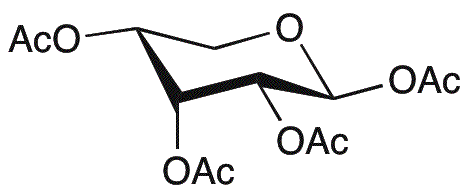1,2,3,4-Tetra-O-acetyl-b-D-ribopyranose is widely utilized in research focused on:
- Carbohydrate Chemistry: This compound serves as a key intermediate in synthesizing various glycosides and nucleosides, making it essential for researchers developing new pharmaceuticals.
- Biotechnology: It is used in the production of modified ribonucleic acids (RNAs), which are crucial for gene therapy and RNA-based vaccines, providing a foundation for innovative treatments.
- Food Industry: The compound can be employed as a flavoring agent or sweetener due to its sugar-like properties, enhancing the taste profile of various food products.
- Cosmetics: Its moisturizing properties make it a valuable ingredient in skincare formulations, promoting hydration and improving skin texture.
- Research and Development: It is often used in academic and industrial labs for studying carbohydrate interactions and modifications, aiding in the advancement of material sciences.
General Information
Properties
Safety and Regulations
Applications
1,2,3,4-Tetra-O-acetyl-b-D-ribopyranose is widely utilized in research focused on:
- Carbohydrate Chemistry: This compound serves as a key intermediate in synthesizing various glycosides and nucleosides, making it essential for researchers developing new pharmaceuticals.
- Biotechnology: It is used in the production of modified ribonucleic acids (RNAs), which are crucial for gene therapy and RNA-based vaccines, providing a foundation for innovative treatments.
- Food Industry: The compound can be employed as a flavoring agent or sweetener due to its sugar-like properties, enhancing the taste profile of various food products.
- Cosmetics: Its moisturizing properties make it a valuable ingredient in skincare formulations, promoting hydration and improving skin texture.
- Research and Development: It is often used in academic and industrial labs for studying carbohydrate interactions and modifications, aiding in the advancement of material sciences.
Documents
Safety Data Sheets (SDS)
The SDS provides comprehensive safety information on handling, storage, and disposal of the product.
Product Specification (PS)
The PS provides a comprehensive breakdown of the product’s properties, including chemical composition, physical state, purity, and storage requirements. It also details acceptable quality ranges and the product's intended applications.
Certificates of Analysis (COA)
Search for Certificates of Analysis (COA) by entering the products Lot Number. Lot and Batch Numbers can be found on a product’s label following the words ‘Lot’ or ‘Batch’.
*Catalog Number
*Lot Number
Certificates Of Origin (COO)
This COO confirms the country where the product was manufactured, and also details the materials and components used in it and whether it is derived from natural, synthetic, or other specific sources. This certificate may be required for customs, trade, and regulatory compliance.
*Catalog Number
*Lot Number
Safety Data Sheets (SDS)
The SDS provides comprehensive safety information on handling, storage, and disposal of the product.
DownloadProduct Specification (PS)
The PS provides a comprehensive breakdown of the product’s properties, including chemical composition, physical state, purity, and storage requirements. It also details acceptable quality ranges and the product's intended applications.
DownloadCertificates of Analysis (COA)
Search for Certificates of Analysis (COA) by entering the products Lot Number. Lot and Batch Numbers can be found on a product’s label following the words ‘Lot’ or ‘Batch’.
*Catalog Number
*Lot Number
Certificates Of Origin (COO)
This COO confirms the country where the product was manufactured, and also details the materials and components used in it and whether it is derived from natural, synthetic, or other specific sources. This certificate may be required for customs, trade, and regulatory compliance.

